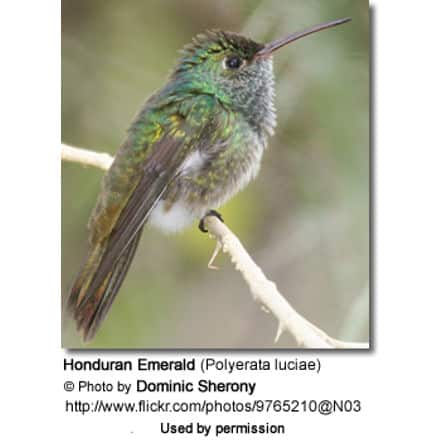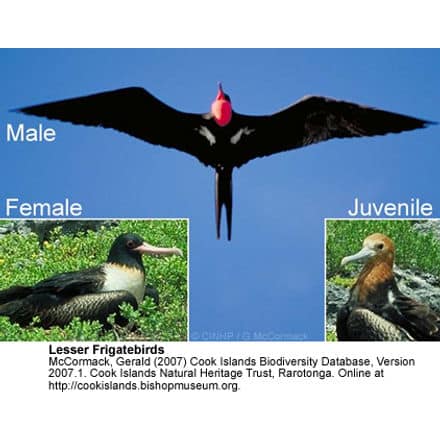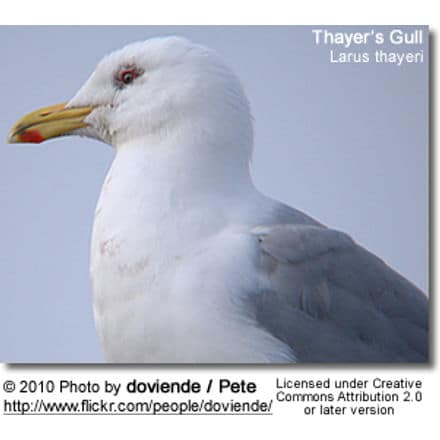Honduran Emeralds (Polyerata luciae) or Lucy’s Emeralds
Hummingbird Information
Overview … Alternate (Global) Names
Distribution / Habitat … Description … Breeding / Nesting … Diet / Feeding … Calls / Vocalizations
The Honduran Emeralds (Polyerata luciae) – also sometimes referred to as Honduras Emeralds or Lucy€™s Emeralds – are critically endangered hummingbirds with a very limited range in the Central American country of Honduras.
Distribution / Habitat
The Honduran Emeralds Hummingbirds are found in the arid interior valleys of northern and central Honduras, where they inhabit dry forests and scrub, open-canopy deciduous thorn forests up to the elevation of about 4,000 feet (~1,220 meters).
These hummingbirds are believed to be resident, except for some seasonal movements in response to the growing seasons of their favored feeding plants.
Description
Size
This medium-sized hummingbird averages 3.7 inches or 9.5 cm in length (including the tail).
Plumage Details / Adults
The upper plumage is bright green with a bronzy tinge on the upper tail-coverts (feathers). The tail is bronze-green.
The male can be identified by his glittering blue-green throat and upper chest, sometimes appearing mottled dusky grey. The rest of the plumage below is pale grey with mottled green sides.
The female has a less intensive throat patch.
The immature bird can be identified by their greyish throat that is spotted turquoise.
Other Physical Details
The upper bill is black and the lower one reddish with a black in the male and entirely blackish in the female.
Diet / Feeding
Honduran Emeralds Hummingbirds are believed to primarily feed on nectar taken from Pedilanthus camporum, Nopalea hondurensis, Aphelandra scabra, and Helicteres guazaumifolia plants, as well as various cacti, thorny shrubs, and low trees, herbs, epiphytes and parasitic species.
They use their long, extendible, straw-like tongues to retrieve the nectar while hovering with their tails cocked upward as they are licking at the nectar up to 13 times per second. Sometimes they may be seen hanging on the flower while feeding.
Many native and cultivated plants on whose flowers these birds feed heavily rely on them for pollination. The mostly tubular-shaped flowers exclude most bees and butterflies from feeding on them and, subsequently, from pollinating the plants.
They may visit local hummingbird feeders for some sugar water, or drink out of bird baths or water fountains where they will either hover and sip water as it runs over the edge; or they will perch on the edge and drink – like all the other birds; however, they only remain still for a short moment.
They also take some small spiders and insects – important sources of protein particularly needed during the breeding season to ensure the proper development of their young. Insects are often caught in flight (hawking); snatched off leaves or branches, or taken from spider webs. A nesting female can capture up to 2,000 insects a day.
Males establish feeding territories, where they aggressively chase away other males as well as large insects – such as bumblebees and hawk moths – that want to feed in their territory. They use aerial flights and intimidating displays to defend their territories.
Breeding / Nesting
As is typical of hummingbirds, the Honduran Emeralds are solitary in all aspects of life other than breeding; and the male’s only involvement in the reproductive process is the actual mating with the female. They neither live nor migrate in flocks, and there is no pair bond for this species.
Most breeding occurs between January and May. Several males perform in leks (communal courtship displays) that involve singing and flying in a u-shaped pattern in front of any females in their territories.
A male will separate from the female immediately after copulation. One male may mate with several females. In all likelihood, the female will also mate with several males. The males do not participate in choosing the nest location, building the nest, or raising the chicks.
The female is responsible for building the deep, cup-shaped nest out of plant fibers woven together and green moss on the outside for camouflage in a protected location in a shrub, bush, or tree. She lines the nest with soft plant fibers, animal hair, and feathers down, and strengthens the structure with spider webbing and other sticky material, giving it an elastic quality to allow it to stretch to double its size as the chicks grow and need more room.
The average clutch consists of two white eggs, which she incubates alone, while the male defends his territory and the flowers he feeds on. The young are born blind, immobile, and without any down.
The female alone protects and feeds the chicks with regurgitated food (mostly partially digested insects since nectar is an insufficient source of protein for the growing chicks). The female pushes the food down the chicks’ throats with her long bill directly into their stomachs.
As is the case with other hummingbird species, the chicks are brooded only the first week or two and are left alone even on cooler nights after about 12 days – probably due to the small nest size. The chicks leave the nest when they are about 7 – 10 days old.
Calls / Vocalizations / Sounds
Their vocalizations are described as buzzy chatters or repeated metallic ticking.
Alternate (Global) Names
Chinese: ?????? … Czech: KolibrÃk honduraský … Danish: Hondurasamazilie … Dutch: Hondurese Amazilia … Finnish: Hondurasintimanttikolibri … French: Ariane de Lucy … German: Honduras Amazilie … Italian: Amazilia dell’Honduras, Smeraldo dell’Honduras … Japanese: honjurasuemerarudohachidori … Norwegian: Honduraskolibri … Polish: szmaragdzik honduraski … Russian: ???????????? ???????? … Slovak: kolibrÃk honduraský … Spanish: Amazilia Hondureña, Amazilia Zafirina, Diamante de Collar, Esmeralda hondureña … Swedish: Hondurassmaragd
Metabolism and Survival and Flight Adaptions – Amazing Facts
Species Research by Sibylle Johnson
Please Note: The articles or images on this page are the sole property of the authors or photographers. Please contact them directly with respect to any copyright or licensing questions. Thank you.







